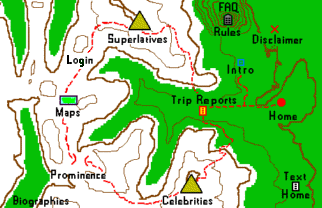
| California County Highpointing *1 |

|
California's geographic and environmental diversity are without
parallel in the United States.
Not merely a region with defined boundaries,
the Golden State
is a state of mind that remains a nexus Writing of county highpoints it IS appropriate to expound in these Plate tectonic forces at North America's western margin built the The great San Joaquin central valley owes its agricultural bounty,
feeding the nation, The geology provides a canvas onto which hard-working pioneers
stitched an economic powerhouse.
There are several physiographic provinces. Southernmost are
the Mojave Desert In the desert, one hikes Blue Angels Peak (Imperial County) only in winter.
San Bernardino County, largest in the contiguous states, hosts San Gorgonio -
southern California's highest. Nearby Riverside County features San Jacinto
rising two vertical miles above Palm Springs; an aerial tram eliminating
3/4 of the elevation gain.
At center, from Pacific to Nevada, are Coastal Ranges, Central Valley, Within this region, one large enough for its own state, are highpoints
to suit anybody's tastes - The Good:
Mount Lyell (Tuolumne County), a 13,114 foot glaciated The Bad:
Yolo County's Little Blue Peak,
a brush-bash guaranteed to force The Illegal:
Several of California's counties have limited access. Most notorious Then there's Mount Whitney (14,505 feet, Inyo and Tulare Counties), In the north, again eastward, are more Coastal Ranges, Majestic Mount Shasta, Siskiyou County, is an extremely impressive
stratovolcano demanding your attention at 100 miles. A standard
ice axe and crampon climb, this sentinel would be the Jefferson
state highpoint were ever that section of California to splinter-off.
The diversity is quantifiable: in the county list every 1,000 foot
elevation range is represented from sea level to over 14,000 feet
(except for 1,000-1,999 feet). No other state lays similar claim
including Alaska.
The diversity allows sampling a state highpoint list subset
by chance similarities of effort and environment:
WHY GO ANYWHERE ELSE?
Completing the county list is daunting. Over two dozen have met
that challenge, requiring a range of skills ... and chutzpah.
However the personal rewards of each summit are singularly savored -
you need not finish the state for cherished memories.
So, as one former Mr. Universe puts it,
"When can you come?".
of promise and opportunity
for generations of westerly-mobile peoples from all corners.
general terms because the economy and geology are interwoven.
Sierra Nevada; and Nineteenth Century gold would not exist otherwise.
to similar titanic forces - which as afterthought
also created 58 county highpoints.
and Transverse Ranges (one of few mountain chains
oriented east-west in the contiguous states).
400 mile long Sierra Nevada, and western fringe of the Great Basin province
extending to Utah.
"The good, The bad, and The Illegal".
peak in the Yosemite National Park high country.
a rethink of what clothing you are willing to sacrifice.
impediment is the electric fence at Long Ridge (San Mateo County).
highpoint of the USA until Alaskan statehood. Get your permit early!!
Klamath Mountains, the Cascade Range's southern end, and Modoc Plateau.
Both are drive-ups with summit astronomical observatories.
Both are all-day hikes with roughly the same distance and elevation gain.
Both are snow climbs requiring ice axe and crampons.
Both are technical rock climbs. "North Pal" is rated Class 4.